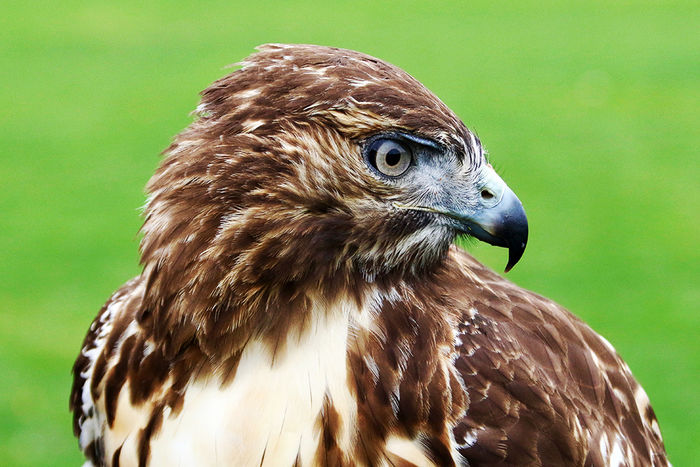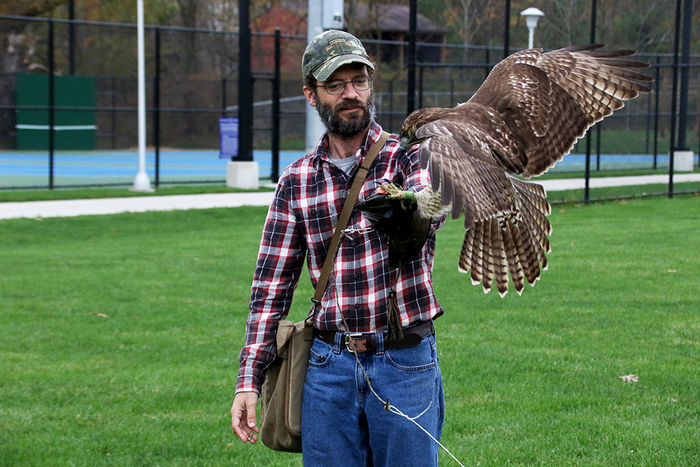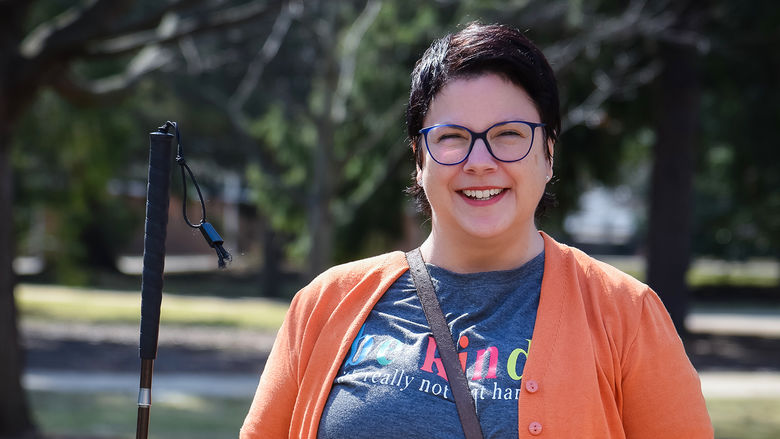

This dialog contains the full navigation menu for this site.

The term “falconry” might conjure up images of the Middle Ages, nobility, and Camelot. But the practice of hunting wild animals using a falcon or hawk goes much further back in time, to around 4,000 years ago, most likely somewhere in the far east. Falconry has been used in all regions of the world across all time periods.
Although now on a smaller scale, falconry is still legally practiced in many places overseas, the United States, Pennsylvania, and even here in Blair County.
Sam Findley is an associate teaching professor of classics and ancient Mediterranean studies at Penn State Altoona. He is also a Pennsylvania-licensed falconer.
“My mother worked at the Stone Zoo in Massachusetts, so until I was 12, I was basically raised by howler monkeys.” A beat. “I'm also fascinated with the practices that surround the keeping of odd animals and philosophically fascinated by the training relationship between humans and animals.”
Findley was introduced to falconry while volunteering at Shaver’s Creek Environmental Center in Huntingdon County. He had always been a hunter but gave up using guns to do so about six years ago. The thought of being able to hunt again with a different method combined with the potential to connect with a wild animal and nature drew him to falconry.
Findley explains that in the twenty-first century, falconry is about keeping an old tradition alive in the correct way. “It's not just having an unusual pet. If you take that bird out of the wild and don't let it hunt, you're not allowing it to attain its full potential, and that's unethical. So, falconry is maintaining the history and keeping it alive by actually using the practice.”
Findley decided to further pursue falconry by contacting the Pennsylvania Falconry and Hawk Trust and meeting with a couple of falconers. After hawking with one for a year, Findley decided it was something he truly wanted to do.

Sam Findley's latest partner, a red-tailed hawk.
Becoming a falconer is a rigorous process involving state and federal licensing, an exam, and facility inspections. New falconers are also required to serve an apprenticeship under a general or master falconer for at least two years. Each step of this system is in place to ensure the health and safety of the birds, to ensure the sport is practiced at the highest level, and to thoroughly prepare the apprentice to be a vital part of the tradition they will carry forth.
The first lesson is that falconry is time-consuming, requires a lot of effort, and can be costly. Second, it’s nothing like being a pet owner. It is not like having a fluffy kitten to play with and cuddle—no, these birds are not for companionship. They have no social instinct and will offer nothing more than mere tolerance to their falconers.
“Keeping a raptor is a very delicate task that requires a lot of patience, so training is vital. There are all sorts of tricks of the trade you can only learn by doing,” explains Findley. “Your chances of doing things wrong are high as are your chances of accidentally injuring your bird, so you want to have somebody looking over your shoulder very closely.”
Findley met with his sponsor frequently, and he started to learn the types of raptors, falconry terminology, the traditional methods of making equipment, and the tasks required to keep a raptor in good health. He was also able to get into the field and learn how to hunt.
Findley began his apprenticeship with a red-tailed hawk that he named Hedris.
American falconry stays true to the practice’s authentic roots in many ways. One is that American falconers are permitted to trap juvenile birds from the wild, whereas, in many other countries, birds are purchased from captivity. Wild juveniles, called “passage birds” by falconers, have around an 80% mortality rate in their first year; by only working with these juveniles, falconers make sure that they are not affecting the breeding population of wild hawks.
Trapped juveniles have already been hunting on their own for a bit of time, and training is initially to acclimate the bird to accept the falconer as a keeper and partner in the field. It’s a delicate relationship, explained simply here.

Sam Findley and his red-tailed hawk training at Penn State Altoona.
“We first have to tame them down. In that process, I’m trying to teach them to hunt my gloved fist and ignore any fear associations with me,” says Findley.
The amount of time the bird spends carried on the falconer’s gloved fist is crucial. When it recognizes the falconer and the glove as a source of food, it will start to tame down. The falconer never denies the bird food, rather asks it to earn it, initially by the hawk feeding from the glove, then by having it jump a short distance while tethered to a lightweight training line.
Then, the glove is moved further and further away; 10 feet, 30 feet, 50 feet. Once the bird flies to the falconer from about 70 feet, it’s time to try flying free. In this stage, the bird is introduced to wild game in a process known as “entering.” When the hawk has achieved its first kill, the training is complete. By this time, it is hoped that a positive enough bond has formed between falconer and hawk that the bird will fly to an outstretched arm.
“But you're not keeping a raptor for the purpose of training it,” states Findley. “You're keeping it for the purpose of maximizing its potential while getting the opportunity to be a deep witness to nature. That means hunting.”
What these birds like most in the world is to hunt prey, so now it is time to let them do what their instincts drive them to do.
Findley says during the hunt, he acts as a flushing dog, much like one that rustles out pheasants for a hunter with a gun. Once a hawk figures out that if it follows its falconer in the woods, squirrels and other prey will appear, it wants to continue following the human.
But the transition from free flight to hunting is a delicate one, as well. “During that period when they don't associate you with prey, but they do associate your glove with food, it's not the association that drives their being. Hawks exist to hunt, so if they were to see prey across the valley, and you hold up your glove and say, ‘Look, look, food,’ they're going to take off for the prey.”
Luckily, in this modern era, falconers often fly their birds with small radio transmitters that emit a beep, and they use tracking receivers to track them down. Somewhat unluckily, this can often mean traversing through fields and streams, mountains, and valleys for hours locating a wayward bird. It involves knocking on doors, trying to explain to homeowners why a stranger holding a weird-looking antenna needs access to their backyard and why a giant bird is perched in one of their trees or on top of their garage.
Findley recounts an incident three days into free flight with his current red-tailed hawk, Nicey Melinda, named after a doll in a children’s book. “She saw something across the valley and took off, so I radio-tracked her for an hour, through three of my neighbors' backyards and hiking through a pasture and over a fence. I finally found her, held up my glove, and she flew back across the valley to exactly where we had been, so I had to do the whole thing again. Then I just sat underneath a tree waiting for her to remember that my glove had positive associations and fly down to me.” The whole thing took about three hours.
When a trained hawk has made a kill, the falconer holds a small piece of meat in his glove between the hawk’s beak and the carcass. The hawk transfers its attention to the glove, leaving the game to be transferred into the falconer’s game bag. “I'll hold my glove out and kneel on top of whatever it is that she's caught and killed. Birds are so visual that if they can't see something, it doesn't exist. She'll see my gloves, see the yummy thing, and hop up to the glove, and then I'll sneak the catch into my bag.”

Sam Findley trains with a red-tailed hawk on the intramural fields at Penn State Altoona
Findley isn’t greedy, though, typically sharing the spoils with Nicey Melinda. She gets the squirrels and they split the rabbit meat. Pheasants, though, are all Findley’s.
For the many frustrations that can come with training and hunting with a raptor, Findley finds it interesting and fun.
“Hawks think so differently from us, so training them is fascinating to me. When I was sitting under the tree the day Nicey Melinda took off, I was trying to figure out what she was thinking. Why she did fly away? Had I not been careful enough or hadn't I gotten the right variables in the situation established yet? Why is she behaving this way? What do I have to do to elicit from this completely alien mind these behaviors that I want?”
Findley says the training relationship with a raptor isn’t about becoming the animal’s master, but rather connecting with it, then connecting with the wilderness that surrounds them both.
Findley became a fully licensed falconer in 2019. He spends at least an hour every day with Nicey Melinda, often longer. For him, everything about falconry goes much deeper than just the hunt—it’s something sacred.
“I have days, especially in the wintertime, when I get depressed. Having a hawk to train or hunt with means I have to go outside. For that hour, two hours, however long, I’m totally focused on my bird, totally immersed in nature, and completely a part of the natural process of the wild in a very deep way.”
Findley says falconry has brought him to the highest of highs and lowest of lows with success, failure, pride, sorrow, and loss. At times, he’s felt several of those emotions at once.
As part of American falconry, the birds are released back into the wild after one or two hunting seasons, ready to join the breeding population and prepared to be competent hunters. These birds are never domesticated—they become comfortable with their handlers and get used to their mews, which are game warden-approved hawk houses, but they remain wild as ever. When released they immediately return to their instinctive ways.
“Releasing my red-tailed last spring was, on one hand, kind of sad. I’d suffered and slaved for this bird for two years. On the other hand, I was very satisfied, because this is how it's supposed to be. I was satisfied but very quiet for the next several days.”
And then he began the process all over again.
Today, there are about 4,000 licensed falconers in the United States, with less than 200 in Pennsylvania, a unique hobby, to be sure. While it’s mostly about being outside hunting with his bird, Findley will talk about falconry to anyone and everyone. And every now and then, he even lets himself feel a small sense of accomplishment. “I spent four years of my life getting certified to do this. It was hard and involved, so there is a certain sense of satisfaction there.”
Comparatively new to the practice, Findley is careful not to present himself as an exemplar of the falconry tradition. However, his newness is yet another aspect of falconry he is very much enjoying. “It's something that I didn't know much about five years ago, so it gave me an opportunity to learn. This whole new world and history opened up to me, and that's exciting.”
Findley is also meeting new people and using his experiences to foster his academic pursuits. He wrote an article about the philosophy of hunting based on a few of his own hunts that appeared in the December issue of Hawk Chalk, a North American Falconers Association publication. He also regularly attends Pennsylvania Falconry and Hawk Trust field meets.
“You could say that my academic career has always been about preserving traditions that are in danger of being forgotten, that are cultural treasures of the past. Preserving those things, which now includes falconry, personally and professionally is what my life is all about.”
Perhaps it is not such an odd thing, after all, a professor of Greek and Roman culture who is also a falconer.


